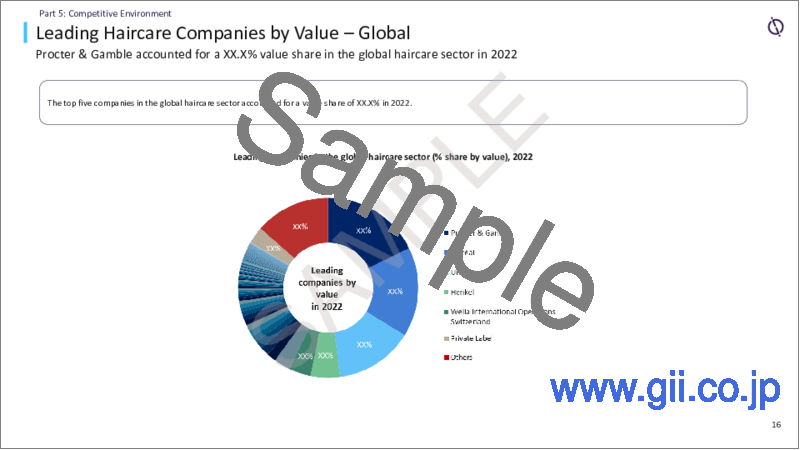|
|
市場調査レポート
商品コード
1345182
ヘアケアの世界市場:2027年までの分析Global Haircare Market Analysis to 2027 |
||||||
カスタマイズ可能
適宜更新あり
|
|||||||
| ヘアケアの世界市場:2027年までの分析 |
|
出版日: 2023年08月08日
発行: GlobalData
ページ情報: 英文
納期: 即納可能
|
- 全表示
- 概要
- 図表
- 目次
世界のヘアケアの市場規模は、2022年に796億米ドルとなりました。同市場は、2022年~2027年に4.4%のCAGRで拡大し、2027年には988億米ドルに達すると予測されています。数量ベースでは、この分野は2022年の170億個から2027年には186億個に成長すると予測されています。2022年における世界のヘアケア分野の最大地域はアジア太平洋で、金額シェアは38.9%、次いで南北アメリカの33.9%でした。
2022年には、シャンプーが金額ベースでも数量ベースでも世界最大のカテゴリーとなり、それぞれ42.3%と49%のシェアを占めました。中東・アフリカのヘアケア部門は、予測期間中最も速い金額CAGR14.7%を記録すると予測されます。世界のヘアケア部門の上位5社の2022年の金額シェアは57.1%でした。同部門を牽引したのはProcter & Gambleで、17.8%のシェアを占め、L'OrealとUnileverがそれぞれ16.1%と14%で続いた。他の大手2社、HenkelとWella International Operations Switzerlandの金額シェアは、それぞれ5.3%と3.9%でした。
世界のヘアケア分野で最も広く使用されている包装材料は硬質プラスチックで、57.5%の数量シェアを占め、次いで軟包装の35.4%でした。ボトルは55%のシェアで最も使用されています。フリップ/スナップトップは最も使用されているクロージャータイプで、45.1%の数量シェアを占めています。カートン-折りたたみ式一次外装タイプは2022年に12.2%の数量シェアを占めました。
消費者の間で髪の健康に対する関心が高まる中、ヘアケア製品に天然成分や植物由来成分を求める声が高まっています。消費者は有害物質を含まない成分を求めており、パラベン、ポリエチレン、ブチルヒドロキシアニソールなどの有害な化学物質を避けています。その結果、メーカーは自然由来の安全な成分を使ったヘアケア製品を処方するようになっています。ヘアケア業界は表示に関する規制が厳しく、メーカーは良質な成分を配合したクリーンラベルの商品を製造することが求められています。消費者は、明確な情報を提供する製品を選ぶようになってきています。そのため、ブランドは製品の使用における安全性を高めるため、パックラベルでのコミュニケーションを強化することに注力しています。
当レポートでは、世界のヘアケア市場について調査し、企業とブランドのシェア分析、競合情勢などを提供しています。
目次
第1章 セクターの概要
第2章 健康と美容の価値シェアパターンの変化
- ヘルス&ビューティー業界全体の消費レベルの変化、2022年~2027年
- 消費パターンの変化の理由
第3章 有望国の特定
- リスクリワード分析に基づく10か国の分析(市場評価、経済発展)
- 社会人口動態要因、ガバナンス指標、技術インフラ
第4章 各国の詳細分析
- 有望国の分析
- 今後の展望
第5章 競合情勢
- 価値別の主要企業- 世界
- 企業とブランドのシェア分析- 世界
- 企業とブランドのシェア分析- 地域別
第6章 競合情勢-市場分析
第7章 プライベートブランドの市場シェア
- プライベートブランドシェア分析、地域別
- プライベートブランドシェア分析、カテゴリ別
第8章 分野別の主要な流通チャネル
- 主要な流通チャネルのシェア- 世界レベルおよび地域レベル
第9章 主要なパッケージング形式
- キーパックの材質とパックのタイプ別増加分析
- クロージャータイプとプライマリアウタータイプ別成長分析
第10章 業界指標の選択
付録
- 定義
- GlobalDataについて
List of Tables
List of Tables
- Key categories by value and volume, 2022 vs 2027 - Global
- Key categories by value and volume, 2022 vs 2027 - Asia-Pacific
- Key categories by value and volume, 2022 vs 2027 - Middle East and Africa
- Key categories by value and volume, 2022 vs 2027 - Americas
- Key categories by value and volume, 2022 vs 2027 - Western Europe
- Key categories by value and volume, 2022 vs 2027 - Eastern Europe
- Vietnam: Category share
- Indonesia: Category share
- Indonesia: Consumption by gender
- Indonesia: Consumption by age group
- Indonesia: Consumption by education
- Indonesia: Consumption by degree of urbanization
- Indonesia: Volume share analysis of top 10 cities (%), 2017-22
- Chile: Category share
- Chile: Consumption by gender
- Chile: Consumption by age group
- Chile: Consumption by education
- Chile: Consumption by degree of urbanization
- Chile: Volume share analysis of top three cities (%), 2017-22
- The US: Category share
- The US: Consumption by gender
- The US: Consumption by age group
- The US: Consumption by education
- The US: Consumption by degree of urbanization
- The US: Volume share analysis of top 10 cities (%), 2017-22
- Germany: Category share
- Germany: Consumption by gender
- Germany: Consumption by age group
- Germany: Consumption by education
- Germany: Consumption by degree of urbanization
- Germany: Volume share analysis of top 10 cities (%), 2017-22
- The UK: Category share
- The UK: Consumption by gender
- The UK: Consumption by age group
- The UK: Consumption by education
- The UK: Consumption by degree of urbanization
- The UK: Volume share analysis of top 10 cities (%), 2017-22
- Denmark: Category share
- Denmark: Consumption by gender
- Denmark: Consumption by age group
- Denmark: Consumption by education
- Denmark: Consumption by degree of urbanization
- Denmark: Volume share analysis of top four cities (%), 2017-22
- Czech Republic: Category share
- Czech Republic: Consumption by gender
- Czech Republic: Consumption by age group
- Czech Republic: Consumption by education
- Czech Republic: Consumption by degree of urbanization
- Czech Republic: Volume share analysis of top four cities (%), 2017-22
- Romania: Category share
- Romania: Consumption by gender
- Romania: Consumption by age group
- Romania: Consumption by education
- Romania: Consumption by degree of urbanization
- Romania: Volume share analysis of top eight cities (%), 2017-22
- Saudi Arabia: Category share
- Saudi Arabia: Consumption by gender
- Saudi Arabia: Consumption by age group
- Saudi Arabia: Consumption by education
- Saudi Arabia: Consumption by degree of urbanization
- Leading companies in the global haircare sector (% share by value), 2022
- Key pack material volume share (%), 2022
- Annual volume growth by pack material (%), 2017-27
- Key pack type volume share (%), 2022
- Annual volume growth by pack type (%), 2017-27
- Key closure type volume share (%), 2022
- Annual volume growth by closure type (%), 2017-27
- Key primary outer type volume share (%), 2022
- Annual volume growth by primary outer type (%), 2017-27
- Global health & beauty industry patent filings, 2022
- Health & beauty industry patent filings by leading companies, 2022
- Total health & beauty industry patent filings for key markets, 2022
- Total job postings in health & beauty industry by company, 2022
- Job postings in health & beauty industry by theme, 2022
- Deals in health & beauty industry by geography, 2022
List of Figures
List of Figures
- Change in consumption value levels in overall health & beauty industry, 2022-27
- Change in consumption levels in overall health & beauty industry - Asia-Pacific, 2017-27
- Change in consumption levels in overall health & beauty industry - Middle East and Africa, 2017-27
- Change in consumption levels in overall health & beauty industry - Americas, 2017-27
- Change in consumption levels in overall health & beauty industry - Western Europe, 2017-27
- Change in consumption levels in overall health & beauty industry - Eastern Europe, 2017-27
- Identifying high-potential countries, risk-reward analysis - Asia-Pacific
- Identifying high-potential countries, risk-reward analysis - Middle East and Africa
- Identifying high-potential countries, risk-reward analysis - Americas
- Identifying high-potential countries, risk-reward analysis - Western Europe
- Identifying high-potential countries, risk-reward analysis - Eastern Europe
- Indonesia: Volume share analysis of top 10 cities by category (%), 2022
- Chile: Volume share analysis of top three cities by category (%), 2022
- The US: Volume share analysis of top 10 cities by category (%), 2022
- Germany: Volume share analysis of top 10 cities by category (%), 2022
- The UK: Volume share analysis of top 10 cities by category (%), 2022
- Denmark: Volume share analysis of top four cities by category (%), 2022
- Czech Republic: Volume share analysis of top four cities by category (%), 2022
- Romania: Volume share analysis of top four cities by category (%), 2022
- Top five companies' shares by brand (in value terms) in global haircare sector, 2022
- Top five companies' shares by brand (in value terms) in Asia-Pacific haircare sector, 2022
- Top five companies' shares by brand (in value terms) in Middle East and Africa haircare sector, 2022
- Top five companies' shares by brand (in value terms) in Americas haircare sector, 2022
- Top five companies' shares by brand (in value terms) in Western European haircare sector, 2022
- Top five companies' shares by brand (in value terms) in Eastern European haircare sector, 2022
- Key brands - conditioner, 2022
- Key brands - hair colorants, 2022
- Key brands - hair loss treatments, 2022
- Key brands - perms & relaxers, 2022
- Key brands - shampoo, 2022
- Key brands - styling agents, 2022
- Private label value and share by region, 2017-22
- Private label value sales ($ million) and share (%) by category, 2022
- Leading distribution channels by region (% share by value), 2022
Abstract
Global Haircare sector was valued at $79.6 billion in 2022 and is forecast to record a CAGR of 4.4% during 2022-27, to reach $98.8 billion in 2027. In volume terms, the sector is forecast to grow from 17 billion units in 2022 to 18.6 billion in 2027. Asia-Pacific represented the largest region for the global haircare sector in 2022, with a value share of 38.9%, followed by the Americas with 33.9%.
In 2022, shampoo was the largest category in both value and volume terms globally, with shares of 42.3% and 49%, respectively. The haircare sector in the Middle East and Africa is forecast to record the fastest value CAGR at 14.7% over the forecast period. The top five companies in the global haircare sector together accounted for a value share of 57.1% in 2022. The sector was led by Procter & Gamble, which held a value share of 17.8%, followed by L'Oreal and Unilever with shares of 16.1% and 14%, respectively. The other two leading companies, Henkel and Wella International Operations Switzerland, accounted for value shares of 5.3% and 3.9%, respectively.
Rigid plastics was the most widely used pack material in the global haircare sector, accounting for a 57.5% volume share, followed by flexible packaging with a 35.4% share. Bottle was the most used pack type with a 55% share. Flip/snap top was the most used closure type, accounting for a volume share of 45.1%. The carton - folding primary outer type held a volume share of 12.2% in 2022.
With growing concerns around hair health among consumers, there has been an increase in demand for natural and plant-based ingredients in haircare products. Consumers are looking for toxin-free ingredients and are avoiding harmful chemicals such as parabens, polyethylene, and butylated hydroxyanisole. As a result, manufacturers are formulating haircare products using naturally sourced and safe ingredients. The haircare industry is highly regulated in terms of labeling, while manufacturers are expected to produce clean-label items with good-quality ingredient formulations. Consumers are increasingly opting for products that provide clear information. Therefore, brands are focusing on strengthening their communication on pack labels, to increase safety in product usage.
The report "Global Haircare Market Analysis to 2027"provides an overview of current haircare scenario regarding the future outlook in terms of ingredients, product claims, labeling, distribution, and packaging. The analysis also covers regional overview across five regions - Asia-Pacific, Middle East and Africa, Americas, Western Europe, and Eastern Europe - highlighting industry size, growth drivers, latest developments, and future inhibitors for the regions.
Scope
This report brings together multiple data sources to provide a comprehensive overview of the global haircare sector, analyzing data from 108 countries. It includes analysis on the following -
- Sector overview: Provides an overview of the current sector scenarios in terms of ingredients, manufacturer claims, labeling, and packaging. The analysis also provides a regional overview across five regions Asia-Pacific, the Middle East and Africa, the Americas, Western Europe, and Eastern Europe highlighting sector size, growth drivers, the latest developments, and future challenges for each region. This data includes both on-trade and off-trade data.
- Change in consumption: Provides an overview of consumption changes in the overall health and beauty industry, including haircare products, over 2017-27 at global and regional levels.
- High-potential countries: Provides risk-reward analysis of the top two high-potential countries in each region based on market assessment, economic development, governance indicators, socio-demographic factors, and technological infrastructure.
- Country and regional analysis: Provides a deep-dive analysis of 10 high-potential countries, covering value growth during 2022-27, key challenges, consumer demographics, and key trends. It also includes regional analysis covering the future outlook for each region. Market size includes both on-trade and off-trade data, while only off-trade data is used in company and brand analysis, distribution analysis, and packaging analysis.
- Competitive landscape: Provides an overview of the leading brands at a global and regional level. This section also analyzes the product profile, country-level presence, market share, and the growth of private labels in each region.
- Key distribution channels: Provides an analysis of the leading distribution channels in the global haircare sector in 2022. It covers "dollar stores", variety stores and general merchandise retailers, cash & carries and warehouse clubs, convenience stores, department stores, e-retailers, hypermarkets & supermarkets, parapharmacies/drugstores, health & beauty stores, chemists/pharmacies, direct sellers, and others.
- Packaging analysis*: The report provides percentage share (in 2022) and growth analysis (during 2022-27) for various pack materials, pack types, closures, and primary outer types based on volume sales of haircare products.
Reasons to Buy
- Manufacturers and retailers seek latest information on how the market is evolving to formulate their sales and marketing strategies. There is also demand for authentic market data with a high level of detail. This report has been created to provide its readers with up-to-date information and analysis to uncover emerging opportunities of growth within the sector in the region
- The report provides a detailed analysis of the countries in the region, covering the key challenges, competitive landscape and demographic analysis, that can help companies gain insight into the country specific nuances
- The analysts have also placed a significant emphasis on the key trends that drive consumer choice and the future opportunities that can be explored in the region, than can help companies in revenue expansion
- To gain competitive intelligence about leading brands in the sector in the region with information about their market share and growth rates
Table of Contents
Table of Contents
- Executive Summary
Part 1: Sector Overview
- Current Scenario and Future Outlook
- Global Haircare Sector Overview - What Are the Growth Factors, Latest Developments, and Future Inhibitors?
- Regional Haircare Overview - What Are the Growth Factors, Latest Developments, and Future Inhibitors?
- Key Challenges in the Global Haircare Sector
Part 2: Shift in Health & Beauty Value Share Patterns
- Change in Consumption Levels in the Overall Health & Beauty Industry, 2022-27
- Reasons for Shift in Consumption Patterns
Part 3: Identifying High-Potential Countries
- Analysis of 10 Countries on the Basis of Risk-Reward Analysis (Market Assessment, Economic Development,
- Sociodemographic Factors, Governance Indicators, and Technological Infrastructure)
Part 4: Country Deep-Dive Analysis
- High-Potential Country Analysis
- Future Outlook
Part 5: Competitive Landscape
- Leading Companies by Value - Global
- Company and Brand Share Analysis - Global
- Company and Brand Share Analysis - by Region
Part 6: Competitive Landscape - Market Analysis
Part 7: Market Share of Private Labels
- Private Label Share Analysis by Region
- Private Label Share Analysis by Category
Part 8: Leading Distribution Channels by Sector
- Share of Key Distribution Channels - Global and Regional Levels
Part 9: Key Packaging Formats
- Growth Analysis by Key Pack Material and Pack Type
- Growth Analysis by Closure Type and Primary Outer Type
Part 10: Select Industry Metrics
- Global Patent Filings
- Global Job Analytics
- Global Deals
Appendix
- Definitions
- About GlobalData






